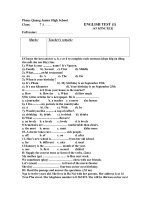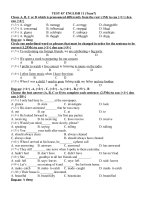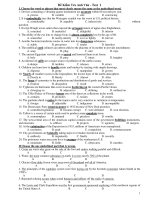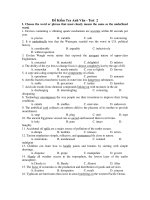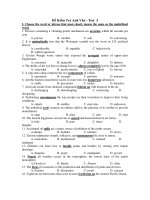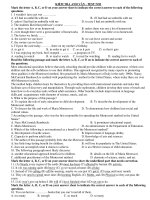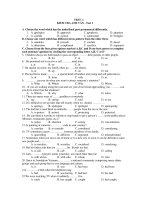TEST 72 ANH VĂN
Bạn đang xem bản rút gọn của tài liệu. Xem và tải ngay bản đầy đủ của tài liệu tại đây (36.61 KB, 7 trang )
TEST 72
Mark the letter A, B, C, or D on your answer sheet to indicate the word whose underlined part differs
from the other three in pronunciation in each of the following questions.
Question 1.
A. frame
B. artisan
C. attraction D. handicraft
Question 2.
A. booked
B. missed
C. described D. pronounced
Mark the letter A, B, C, or D on your answer sheet to indicate the word that differs from the other three
in the position of primary stress in each of the following questions.
Question 3.
A. museum
B. position
C. recommend
Question 4.
A. imagine
B. horizon
C. property
D. commitment
D. computer
Mark the letter A, B, C, or D on your answer sheet to indicate the correct answer to each of the
following questions.
Question 5. Nam and his family had __________ to their home village.
A. a two-day trip
B. a two-days trip
C. a two-day trips
D. two-day trips
Question 6. Hoa hoped __________ to join the club. She could make friends with many people here.
A. being invited
B. to invite
C. to be invited
D. inviting
Question 7. She was tired and couldn’t keep __________ the group.
A. up with
B. up against C. on to
D. out of
Question 8. Vietnamese parents normally do not let their children make a decision __________ their own
future career.
A. in
B. of
C. on D. for
Question 9. He lost his job because he was __________. He made so many mistakes.
A. rashB. cautious
C. inefficient D. impulsive
Question 10. A recent survey has shown that __________ increasing number of men are willing to share
the housework with their wives.
A. a
B. an C. the D. some
Question 11. Bill often says he __________ boxing because it __________ a cruel sport.
A. had not liked/ was
B. not liked/ had been
C. does not like/ is
D. did not like/ were
Question 12. The size and shape of a nail depend primarily on the function __________ intended.
A. which it is B. for which it is
C. which it is for
D. for which is
Question 13. They were extremely tired at the end of the journey because they __________ for more than
24 hours.
A. have travelled
B. have been travelling
C. had travelled
D. had been travelling
Question 14. I don’t suppose there is anyone there, __________ ?
A. do I B. isn’t there C. is there
D. don’t I
Question 15. My aunt used to be a woman of great __________, but now she gets old and looks pale.
A. beauty
B. beautiful
C. beautifully D. beautify
Question 16. I thought the party __________ really well.
A. came off
B. came up
C. came aboutD. came across
Question 17. If __________, that tree would look more impressive.
A. it is done carefully
B. being done careful
C. it were careful done
D. it were carefully done
Question 18. Such a doctor __________ retire from his job before the retirement age.
A. as well as B. may as wellC. so as to
D. as much as
Mark the letter A, B, C, or D on your answer sheet to indicate the word(s) CLOSEST in meaning to the
underlined word(s) in each of the following questions.
Question 19. When Susan invited us to dinner, she really showed off her culinary talents. She
prepared a feast - a huge selection of dishes that were simply mouth-watering.
A. relating to medical knowledge
B. involving hygienic conditions and diseases
C. concerning nutrition and health D. having to do with food and cooking
Question 20. The Civil War in 1863 cut the United States into two nations - a southern Confederacy
and a northern Union.
A. acknowledged
B. alienated
C. severed
D. integrated
Mark the letter A, B, C, or D on your answer sheet to indicate the word(s) OPPOSITE in meaning to the
underlined word(s) in each of the following questions.
Question 21. Lisa rarely smiles because she’s shy about exposing her crooked teeth.
A. pulling
B. hiding
C. showing
D. brushing
Question 22. Her physical condition was not an impediment to her career as a singer. She has won a
lot of prizes.
A. advantage B. obstacle
C. barrier
D. disadvantage
Mark the letter A, B, C, or D on your answer sheet to indicate the option that best completes each of the
following exchanges.
Question 23. Mary is talking to a porter in the hotel lobby.
- Porter: “Shall I help you with your suitcase?”
- Mary: “_____________.”
A. Not a chance.
B. That’s very kind of you.
C. I can’t agree more.
D. What a pity!
Question 24. - Customer: “Can I try this sweater on?”
- Salesgirl: “__________”
A. No, the shop is closed in half an hour.
B. Sorry, only cash is accepted here.
C. Yes, it is quite cheap. It costs one hundred dollars.
D. Sure, the changing rooms are over there.
Read the following passage and mark the letter A, B, C, or D on your answer sheet to indicate the
correct word or phrase that best fits each of the numbered blanks from 25 to 29.
Library is a collection of books and other informational materials made available to people for reading,
study, or reference. The central mission of a library is to collect, organize, preserve, and provide access
to knowledge and information. In fulfilling this mission, libraries preserve a valuable record of culture
that can be passed down to (25)__________ generations. Libraries are an essential link in this
communication between the past, present, and future. Whether the cultural record is contained in
books or in electronic formats, libraries ensure (26)__________ the record is preserved and made
available for later use.
People use library resources to gain information about personal (27)__________ or to obtain recreational
materials such as films and novels. Students use libraries to supplement and enhance their classroom
experiences, to learn (28)__________ in locating sources of information, and to develop good reading and
study habits. Public officials use libraries to research legislation and public policy issues. One of the
most valued of all cultural institutions, the library (29)__________ information and services that are
essential to learning and progress.
Question 25. A. success
B. succeeding C. succeed
Question 26. A. that B. which
C. what
D. successful
D. who
Question 27. A. appeals
B. interests
C. profits
D. attractions
Question 28. A. skills
B. talents
C. capabilities D. abilities
Question 29. A. relates
B digests
C supplies
D. apohes
Read the following passage and mark the letter A, B, C, or D on your answer sheet to indicate the
correct answer to each of the questions from 30 to 34.
The main difference between urban growth in Europe and in the American colonies was the slow
evolution of cities in the former and their rapid growth in the latter. In Europe they grew over a period
of centuries from town economies to their present urban structure. In North America, they started as
wilderness communities and developed to mature urbanism’s in little more than a century.
In the early colonial day in North America, small cities sprang up along the Atlantic Coastline, mostly
in what are now New America, small cities sprang up along the Atlantic United States and in the lower
Saint Lawrence valley in Canada. This was natural because these areas were nearest England and
France, particularly England, from which most capital goods (assets such as equipment) and many
consumer goods were imported Merchandising establishments were, accordingly, advantageously
located in port cities from which goods could be readily distributed to interior settlements. Here, too,
were the favored locations for processing raw materials prior to export. Boston, Philadelphia, New
York, Montreal, and other cities flourished, and, as the colonies grew, these cities increased in
importance.
This was less true in the colonial South, where life centered around large farms, known as plantations,
rather than around towns, as was the case in the areas further north along the Atlantic coastline. The
local isolation and the economic self-sufficiency of the plantations were antagonistic to the
development of the towns. The plantations maintained their independence because they were located
on navigable streams and each had a wharf accessible to the small shipping of that day. In fact, one of
the strongest factors in the selection of plantation land was the desire to have it front on a water
highway.
When the United States became an independent nation in 1776, it did not have a single city as large as
50,000 inhabitants, but by 1820 it had a city of more than 10,000 people, and by 1880 it had recorded
a city of over one million. It was not until after 1823, after the mechanization of the spinning and
weaving industries, that cities started drawing young people away from farms. Such migration was
particularly rapid following the Civil War (1861-1865).
Question 30. What does the passage mainly discuss?
A. Factors that slowed the growth of cities in Europe.
B. The evolution of cities in America
C. Trade between North American and European cities
D. The effects of the United Sates’ independence on urban growth in New England.
Question 31. The word “they” in paragraph 1 refers to ___________.
A. North American colonies B. cities
C. centuries
D. town economies
Question 32. According to the passage, early colonial cities were established along the Atlantic
coastline of North America due to ___________.
A. an abundance of natural resources
C. proximity to parts of Europe
B. financial support from colonial governments
D. a favorable climate
Question 33. Which of the following did the Atlantic coastline cities prepare for shipment to Europe
during colonial times?
A. Manufacturing equipment
C. Consumer goods
B. Capital goods
D. Raw materials
Question 34. According to the passage, all of the following aspects of the plantation system influenced
the growth of southern cities EXCEPT the ___________.
A. location of the plantations
B. access of plantation owners to shipping
C. relationships between plantation residents and city residents
D. economic self-sufficiency of the plantation
Read the following passage and mark the letter A, B, C, or D on your answer sheet to indicate the
correct answer to each of the questions from 35 to 42.
Desertification is the degradation of once-productive land into unproductive or poorly productive
land. Since the first great urban-agricultural centers in Mesopotamia nearly 6,000 years ago, human
activity has had a destructive impact on soil quality, leading to gradual desertification in virtually
every area of the world.
It is a common misconception that desertification is caused by droughts. Although drought does make
land more vulnerable, well-managed land can survive droughts and recover, even in arid regions.
Another mistaken belief is that the process occurs only along the edges of deserts. In fact, it may take
place in any arid or semiarid region, especially where poor land management is practised. Most
vulnerable, however, are the transitional zones between deserts and arable land; wherever human
activity leads to land abuse in these fragile marginal areas, soil destruction is inevitable.
Agriculture and overgrazing are the two major sources of desertification. Large-scale farming requires
extensive irrigation, which ultimately destroys lands by depleting its nutrients and leaching minerals
into the topsoil. Grazing is especially destructive to land because , in addition to depleting cover
vegetation, herds of grazing mammals also trample the fine organic particles of the topsoil, leading to
soil compaction and erosion. It takes about 500 years for the earth to build up 3 centimeters of topsoil.
However, cattle ranching and agriculture can deplete as much as 2 to 3 centimeters of topsoil every 25
years- 60 to 80 times faster than it can be replaced by nature.
Salinization is a type of land degradation that involves an increase in the salt content of the soil. This
usually occurs as a result of improper irrigation practices. The greatest Mesopotamian empiresSumer, Akkad and Babylon - were built on the surplus of the enormously productive soil of the ancient
Tigris-Euphrates alluvial plain. After nearly a thousand years of intensive cultivation, land quality was
in evident decline. In response, around 2800 BC the Sumerians began digging the huge TigrisEuphrates canal system to irrigate the exhausted soil. A temporary gain in crop yield was achieved in
this way, but over-irrigation was to have serious and unforeseen consequences. From as early as 2400
BC we find Sumerian documents referring to salinization as a soil problem. It is believed that the fall of
the Akkadian Empire around 2150 BC may have been due to a catastrophic failure in land
productivity; the soil was literally turned into salt. Even today, four thousand years later, vast tracks of
salinized land between the Tigris and Euphrates rivers still resemble rock-hard fields of snow.
Soil erosion is another form of desertification. It is a self-reinforcing process; once the cycle of
degradation begins, conditions are set for continual deterioration. As the vegetative cover begins to
disappear, soil becomes more vulnerable to raindrop impact. Water runs off instead of soaking in to
provide moisture for plans. This further diminishes plan cover by leaching away nutrients from the
soil. As soil quality declines and runoff is increased, floods become more frequent and more severe.
Flooding washes away topsoil, the thin, rich, uppermost layer of the earth’s soil, and leaves finer
underlying particles more vulnerable to wind erosion. Topsoil contains the earth’s greatest
concentration of organic matter and microorganisms, and is where most of the earth’s land-based
biological activity occurs. Without this fragile coat of nutrient-laden material, plan life cannot exist. An
extreme case of its erosion is found in the Sahel, a transitional zone between the Sahara Desert and the
tropical African rain forests; home to some 56 million people. Overpopulation and overgrazing have
opened the hyperarid land to wind erosion, which is stripping away the protective margin of the Sahel,
and causing the desert to grow at an alarming rate. Between 1950 and 1975, the Sahara Desert spread
100 kilometers southward through the Sahel.
Question 35. Which of the following statements is true about desertification?
A. It was just as serious in the past as it is today. B. Ancient societies managed the problem
well.
C. It is a fairly recent problem.
D. It has a history as long as that of civilization.
Question 36. The word “arable” in paragraph 2 is closest in meaning to __________.
A. populated B. settled
C. cultivatableD. dry
Question 37. According to the passage, many people’s understanding of desertification is incorrect
because __________.
A. they do not see it as being caused by human activity
B. they see it as being reversible
C. they think of it as a very slow process
D. they do not think of it as a serious problem
Question 38. The word “compaction” in paragraph 3 is closest in meaning to __________.
A. depletion B. compression
C. disruption D. fragmentation
Question 39. According to the passage, agriculture furthers desertification through which of the
following activities
A. Over fertilization
B. The repetitive planting of the same crops
C. The stripping away of native vegetation D. Irrigation
Question 40. The word “degradation” in paragraph 4 is closest in meaning to ___________.
A. contribution
B. rejuvenation
C. consumption
D. deterioration
Question 41. Paragraph 4 of the passage serves mainly to do which of the following?
A. propose a method for dealing with the desertification problem.
B. describe the main cause of desertification in one particular area
C. describe one process that leads to desertification
D. show the progress of desertification down through history
Question 42. The word “leaching” in paragraph 5 is closest in meaning to ___________.
A. washing
B. depositing C. dispersing D. concentrating
Mark the letter A, B, C, or D on your answer sheet to indicate the underlined part that needs correction
in each of the following questions.
Question 43. There are many (A) frequently (B) mentioned reasons why one out of (C) four arrests (D)
involve a juvenile.
Question 44. (A) Because of bad (B) weather conditions, it took (C) the explorers three days (D)
reaching their destination.
Question 45. (A) On the way back home from the library, we saw (B) two of our classmates (C) to cycle
(D) side by side.
Mark the letter A, B, C, or D on your answer sheet to indicate the sentence that is closest in meaning to
each of the following questions.
Question 46. I haven’t gone to the cinema for ten years.
A. It was ten years ago I went to the cinema.
B. The last time I went to the cinema was ten years.
C. I last went to the cinema ten years ago.
D. It’s ten years I haven’t gone to the cinema.
Question 47. I couldn’t have run my business successfully without my father’s money.
A. Had it not been for my father’s money, I couldn’t have run my business successfully.
B. I could have run my business successfully without my father’s money.
C. If I could run my business successfully, my father would give me his money.
D. If I couldn’t have run my business successfully, I would have had my father’s money.
Question 48. “No, I didn’t come to see her that night!”
A. He denied having come to see her that night.
B. He denied to have come to see her that night.
C. He denied not having come to see her that night.
D. He refused to have come to see her that night.
Mark the letter A, B, C, or D on your answer sheet to indicate the sentence that best combines each
pair of sentences in the following questions.
Question 49. The man was shot in the bank robbery. The doctors are operating on him.
A. The man was shot in the bank robbery where the doctors are operating on him.
B. The man whom the doctors are operating on him shot in the bank robbery.
C. The man was whom the doctors are operating on him shot in the bank robbery.
D. The doctors are operating on the man who was shot in the bank robbery.
Question 50. She applied for the job abroad. She wanted to develop herself and earn more money.
A. She applied for the job abroad in order to develop herself and earn more money.
B. So as to earn more money for development, she applied for the job abroad.
C. She applied for the job abroad, so she developed herself and earn more money.
D. To earn more money was the reason why she applied for the job abroad.
